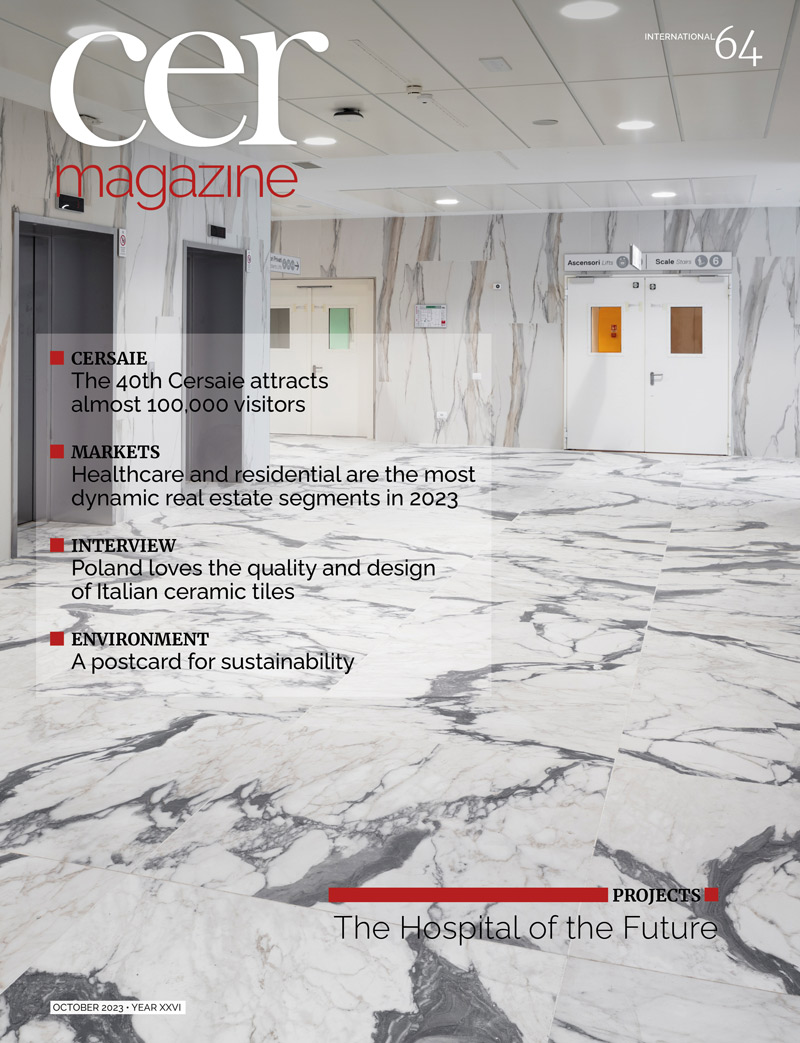As seen at Cersaie 2023
Cersaie recently celebrated its 40th anniversary, a milestone achieved thanks to the vision and foresight of the Italian ceramic tile industry. The show has evolved into a pivotal global marketplace for business meetings and discussions as well as a premier stage for showcasing the unrivalled wealth of technical innovations that Italy has developed over the decades.
The Italian ceramic tile industry has always been renowned for its relentless pursuit of excellence and its ability to consistently surpass its own already remarkable achievements. A closer examination of product innovations reveals that they are backed by extraordinary technology that elevates Italian tiles to a truly unique level.
In light of the ongoing challenges posed by climate change, which have led to increasingly unusual weather patterns in our regions, consumers are demanding safe, reliable and high-quality materials for a building industry that is now exposed to greater risk.
As a response to this demand, the new products unveiled at Cersaie 2023 not only stand out for their high performance and durability but are also aligned with contemporary trends (watch the video of the Products & Trends presentation held during the Ceramics of Italy International Press Conference at Cersaie)
Synthetic nature
Nature remains an enduring source of inspiration but is now viewed as part of a futuristic concept of “synthetic nature” that seeks to meet the needs of modern living, foster innovative design and safeguard our planet.
For forward-looking applications and unique sensory experiences, ceramic innovation creates new material amalgamations that seamlessly blend disparate elements such as wood and marble, concrete and majolica, onyx and marble, stucco and resin and rock and quartzite.
Nature leaves an indelible mark on ceramic surfaces, which artfully replicate the effects of water, wind and the inexorable passage of time, creating three-dimensional and matt textural patterns.
Among the main innovations, we find fresh interpretations of popular products:
Ceppo di Gré, the historical stone widely used for construction in Milan throughout the 20th-century and renowned in particular for its heterogeneous clasts and emerging inclusions, is now being reimagined in a more elegant and gentler version. The material is more compact to allow for wider usage, while new technologies ensure slip resistance and a smooth, easy-to-clean surface.
Stone-effect ceramic tiles mimic sedimentary rocks, replicating the natural irregularities typical of the mineral world and slightly crumbly textures, creating tiles with an extremely authentic look and pleasing colour variations.
The concrete look is experiencing a resurgence, but departing from the brutalism of the 1950s and the domain of great architectural masters. Instead, it has adopted a softer, more homely look characterised by neutral tones, an abundance of mineral fragments and graceful material inclusions.
Similarly, in slate-effect ceramic tiles every detail has been meticulously crafted. The surfaces exude a pleasant dynamism, capturing the myriad shades, striations and tonal variations resulting from the intersection of characteristic slate fissures.
Onyx-effect ceramic tiles are also making a comeback, appreciated for their lightness, depth, vivid hues and subtle shading, while stone-look tiles with more pronounced effects reminiscent of lava, solidified magma or even metal are also gaining prominence. At Cersaie we saw a wealth of textures filled with inclusions and varying grain sizes that in some cases contrast with the metallic and rusty background tones.
Pietra Piasentina reintroduces tone-on-tone effects, adding movement to the surfaces and adapting effortlessly to both indoor and outdoor environments, thanks to extra-thick 2 cm slabs designed specifically for outdoor use.
One cannot help but be captivated by the remarkable surface effects created through the use of 3D technologies. The graphics and texture match perfectly to recreate the distinctive open-hole effect of the original natural stone, enhancing the visual appeal of a material reminiscent of historical floors worn smooth by centuries of foot traffic.
The rich colour palettes, veined textures, bas-reliefs, tonal variations and gradient effects give these tiles an extraordinary resemblance to the natural materials that inspired them, qualities that are faithfully reproduced across a wide variety of sizes.
Smaller tiles, including strips and finger tiles, are also gaining in popularity and allow for original installation patterns together with polished, matte, shaded or toned effects.
At the same time, large-size tiles are becoming ever thinner, with some reaching thicknesses as small as 3.5 mm. This results in a kind of second skin, where the pigmented, powdery surfaces are enhanced with minimalistic material relief designs to create nuanced striations, delicate resonances that add value to the new surfaces.
Attention to lighting is paramount, causing the surfaces to resonate with low and high relief geometric effects and the interplay of projections and recesses, light and shadow.
And to complete the Italian ceramic tile industry’s “mission impossible”, we find furnishing elements such as these slabs that can be transformed into extendable tables as well as strips that cover curved surfaces, create integrated washbasins with pedestals and double basins, cover cylindrical forms, and create countertops in thicknesses ranging from 12 to 20 mm where the veined effect of the surface extends seamlessly along the edge.
Glamorous luxury
Stepping into the realm of the Italian ceramic tile industry feels akin to a grand royal court, where opulence reigns with a profusion of precious and sumptuous products infused with gold, marble, brocade, pearls and gemstones.
Gold permeates ultra-thin “ceramic wallpaper” resembling precious damask or brocade fabric, soft to the touch with intricate patterns that create captivating and luminous backdrops.
Gold also infiltrates sophisticated ceramic wainscoting in nature-inspired neutral tones or blends with ceramic quartzite, a volcanic stone in delicate colour palettes where precious mineral inlays reveal themselves to the touch.
Golden veins run through porcelain slabs emulating Calacatta gold marble sourced from the Apuan Alps, enhanced by the large dimensions, depth and surface sheen. These slabs offer an astonishing tactile and visual sense of radiance and softness. Their elegance, precision, and remarkably lifelike colour, shade variations and veining weave an atmosphere of old-world refinement that seamlessly coexists with contemporary spaces.
Midway between raw stone and the elegance of marble, the most popular surface inspirations – especially in neutral colours – include pearl and mother-of-pearl, talc, chalk, iridescence, gloss and even ice.
As for colours, ceramic marbles display audacious green and rust-hued veins in addition to harmonious combinations of greys, golden yellows, purples, lobster oranges and burnt browns. These hues are reminiscent of eye-catching semi-precious stones such as onyx and quartzite, imparting an elegant sense of natural luxury.
The sophistication of these materials also extends to small sizes, drawing inspiration from traditional craftsmanship and the origins of ceramics.
The metallic finishes offer a spectrum of iridescent hues: platinum, silver, graphite, brass, verdigris, gold, lustre, oxidation, metallisation, through to the material look of brick and the satin colours of waxes.
These audacious new marbles, which seek to capture the beauty of the cosmos and of celestial bodies, come in a wide range of colours, some of which can be combined with neutrals from the same range. Innovative technology guarantees original installation patterns, offering up to 110 unique and non-repetitive faces.
Green emerges as the dominant colour for marble- and gemstone-effect ceramic slabs, ranging from mint and sage through to more vibrant forest and plant-inspired shades. In decorations, these greens create luminous gloss-matt effects and botanical patterns, blending seamlessly with trowelled concrete to create intriguing textural contrasts.
Colour power
Colours lie at the heart of ceramic tiles, commencing with pink and its myriad derivatives.
The palette encompasses silky powder pinks, the transparent allure of quartz and the gentle hues of concrete, all interplaying with various glossy and matt finishes to create original patterns.
Pearl effects take their cue from digital liquid crystals intertwined with fluid colours, offering an ethereal quality and tone-on-tone botanical motifs.
Ceramic marbles and onyxes also have a truly innovative look, with galaxy-like veins in shades of pink, violet, indigo and emerald.
These colours are also found in super-gloss glazed strips in various sizes or in Kit-Kat style finger tiles, which like the iconic chocolate bar are all part of a single ceramic piece.
The colour palettes alternate soft hues such as pinks, greens and natural tones with more vivacious, striking colours reminiscent of a playful pop-culture world evocative of 1990s video games such as Tetris and Pac-Man.
These computer-game-inspired colours take on a more contemporary look thanks to the use of chalky and natural tones created through newly developed ultra-matt, low-light-refraction glazes for non-reflecting surfaces.
Vibrant colours harmonise with warm or neutral tones reminiscent of sands, earth and spices such as turmeric, curry and saffron combined with tribal or ethnic motifs.
Traditional materials such as raw earth, terracotta and hollow tiles are experiencing a revival and are particularly in demand for their high levels of performance. Ceramic emphasises the ancestral material with its intricate details, colour variations and finishes that extend beyond the edges. Thanks to the use of new technology, the surface feels smooth to the touch while maintaining a high coefficient of friction, making it ideal for outdoor use.
There seems to be no limit to the enormous range of products designed and manufactured by the Italian ceramic industry for architectural applications.
The material’s unparalleled versatility makes it ideal for both indoor and outdoor use and for applications in residential and commercial construction. It offers endless aesthetic possibilities and comes in a wide range of sizes, thicknesses, colours and surface finishes. Its unique technical characteristics include wear resistance, slip resistance, guaranteed hygiene and ease of cleaning.
What more could one ask for?
October 2023


























































